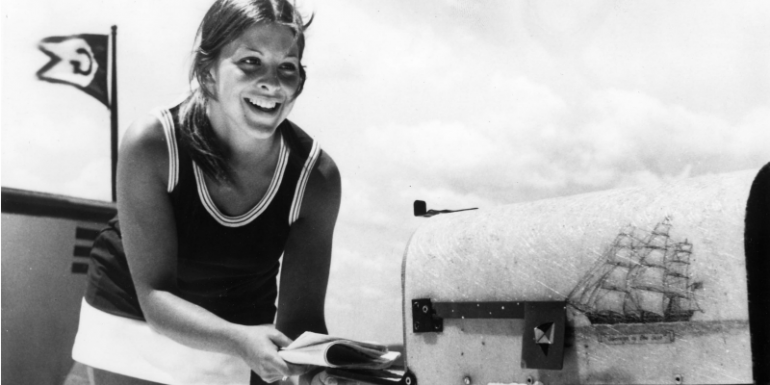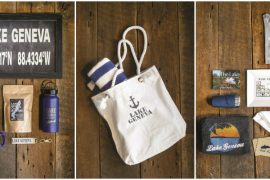When Elaine Kanelos was a child, she had a rather unusual dream: she wanted to be the mailboy who hopped on and off the Walworth II, Geneva Lake’s unique system of mail delivery — the only one of its kind that remains active in the nation.
By 1974 18-year-old Kanelos achieved her dream and the distinction of becoming the Walworth II‘s first mailgirl, an honor that was not lost on the community. Subject of several newspaper stories, including the Wall Street Journal, Kanelos became an overnight celebrity, all because she broke the mold for mail carriers, proving that girls can do anything boys do — even if it means putting mail in her teeth, jumping onto piers and then back onto a moving boat, 60 to 70 times per day. Today the “mailboy” is still a coveted position on Geneva Lake, and girls now tend to be the main staffers, all thanks to one young girl following her dreams.
Elaine’s book, Mail Jumper! can be purchased locally (and also as a e-book on Amazon and Barnes and Noble). She has graciously allowed us to publish an excerpt of Mail Jumper! in the pages that follow.
… My seventh summer, we moved to our own summer house at 668 South Lake Shore Drive. The 1960s style house had one level, an abundance of glass on the lake side and four bedrooms.
… The Mail Boat and the Mail Jumper were already legends to me and all my friends. The Mail Boat came every day. The second one of us spotted it or heard its horn blow, all action stopped. The Mail Boat arrived at our pier at 11:40 AM, and because it tries to stay on schedule its arrival was a fairly reliable vehicle by which to plan the day.
In those days, the Mail Boat was not the Walworth II that I jumped the mail from and which the mail is still delivered by today. Then it was the original Walworth, named after the county in which the Lake and all its shore towns are located.
The original Walworth was built in 1916 for sightseeing on the lake and became the first Mail Boat when water delivery officially started that same year.
A seventy-four foot steamship, she had an elegantly bowed hull, narrow beam and a deck low to the waterline, similar to many of the other Geneva Lake steamships of the era. By the time she was delivering mail to my pier on the south shore, the Walworth had been converted to a gasoline engine and had been carrying passengers and mail around the Lake for nearly 50 years.
… By the time the Mail Boat reached our part of the Lake, we had been in the water for hours. But toast brown and sopping wet, we stopped everything for those few minutes to soak in every detail of the day’s delivery.
Sometimes, one of us would stand at the very tip of the pier and hold out a hand so that the Mail Boy could lean out, one knee hitched over the Walworth’s mahogany handrail and hand us the mail. That was daring on our part, but it didn’t happen very often. We all preferred to watch him jump. Seeing the Mail Boy jump off of the moving boat packed full of wide-eyed passengers was the pinnacle. The best of everything.
It was the sun, the water, the captain telling his tales of the Lake over the boat’s PA system, the tourists, the speed and the Mail Jumper. It was magic.
… In 1967, Gage Marine had retired the Walworth and introduced a new Mail Boat, the Walworth II. Compared to the charm of the original Walworth, the Walworth II was a bit like Shrek. Rather than sleek wood, it had a steel hull and sported a motif of powder blue and white. It rode far higher in the water, and the taller sides closed in the passengers more than the old Walworth. It also had a second deck above the main deck that nearly doubled the passenger capacity.
The new Walworth was built by Schwartz Marine. It weighed 60 tons and was 60 feet long with a 14 foot beam. Rather than a single engine and propeller, this new Mail Boat sported twin diesel 5,208-horsepower engines, making it much more powerful, and importantly, more agile than its predecessor. It was designed with elements uniquely crafted to assist with the mail delivery. Next to the captain’s chair, they had installed a cabinet specifically designed with slots to hold the individual mail deliveries. In addition, Gage had asked Schwartz to design a unique rub rail on the starboard side. Higher on the side of the boat than a rub rail would normally be, it was also about fifteen inches wide, giving the Mail Jumper a more generous landing pad.
The Walworth II may not have been as elegant as its namesake, but it was highly functional. It could go out in rougher waters and provided better shelter to passengers via drop down plastic windows for rainy and windy days. The mail needed to be delivered no matter what the weather, and the Walworth II was built to endure more and be safer during those deliveries.
… I desperately wanted to be outside and on the Lake. Many of my friends were working for the Water Safety Patrol as life guards, and I could have done that. But I didn’t want to do what everyone else was doing.
I wanted to jump the mail. The problem was that only boys jumped the mail. But the world was changing, and I wanted that job. I had wanted it since I was a six year old and I wanted it now.
It was April, my freshman year at CU would be over in a month. So I sat down and composed a letter to Bill Gage that went something like this:
Dear Mr. Gage, I have always dreamed of being the Mail Jumper. I know that the Mail Jumper is traditionally a boy, but I can do the job. I think Gage should hire me as the first girl to jump the mail. I absolutely know I can do it. Sincerely, Elaine Kanelos
About three weeks later I received a letter from Bill saying that I was hired.
I was ecstatic.
… I arrived home [from college] at the end of May and immediately checked in with Bill Gage. As well as I knew the Gage dock and stores in Williams Bay, as the Mail Girl I would be working at Gage’s Riviera Pier location. It was completely different from the Williams Bay boat yard. The Riviera location consisted of a small office for the manager, the ticket office, and the excursion boats.
I was certainly familiar with the Riv pier. It was my water-skiing pick-up location for town friends. There was also a night club on the top floor of the Riviera building called “Top Deck” and I spent many a summer night during college there. But I knew nothing about the Gage Lake Geneva Cruise Line operations at the Riv. It would be a completely new experience to me.
Bill told me to meet him at the Riv dock the following week dressed for work. We were only a few, short weeks away from the June 15 start of mail delivery, and there was lots for me to learn before then.
… “Dressed for work” meant one thing: shopping. I needed Mail Girl clothes. They wanted me in red, white and blue jumpappropriate outfits. I put together outfits comprised of white or navy shorts, tennis skirts or culottes paired with similarly themed tops. I bought outfits for warm, hot, chilly, and rainy weather. While my outfits were all very cute (I thought) and comfortable, the most important item in my Mail Girl wardrobe was my shoes.
… Because I had always been around boats, I knew exactly what shoes I needed. Sperry Top-siders. If you live on or near Lake Geneva, you own Top-siders. So do sailors and boaters around the world. Topsiders are legendary for their ability to maintain grip on slick docks and boats. Created in 1935 by Paul Sperry, the rubber sole of Top-siders are tooled with a pattern of tightly spaced, wave-like grooves that work like the bottom of a dog’s paw to create grip.
… With my apparel and foot-wear ready, I dutifully arrived at the Gage office on the Riviera Pier as instructed. It was a gorgeous early June day, the kind of day that everyone waits all winter to experience. The first order of business was my introduction to Harold Friestad. Harold was the first official boss I would ever have, and as of 2014, he is still running the Lake Geneva Cruise Line.
After meeting Harold, Bill had a bit of a surprise for me. I thought there would be some sort of instruction regarding how you jump off of a speeding boat onto a pier and then back again as fast as you can, but there wasn’t. He had brought along his son, Billy, who was about seven at the time, and a photographer.
We all piled onto the Walworth II and headed out on the Lake.
We were taking publicity shots.
I didn’t even know if I could really do this.
The pier Bill chose for the photos and for my first ever jump as the Mail Girl was my own pier. (I told you it was the easiest pier to jump). It provided more than enough room for the photographer to set up his camera and for me to make several jumps without running into him. I also suppose Bill assumed he wouldn’t have to explain to the pier owner what we were doing.
As a result, in a way that feels somehow poetic to me, the photos that have immortalized me as the first Mail Girl – and which still show up in newspaper articles, books and television news programs – were taken on my own pier showing me putting mail into my own mail box.
I will never forget my first jump. There we were, on my pier, with the very distracting photographer snapping away and Bill, Billy, Harold and Neil Frame, the Captain, shouting encouragements.
Jumping off wasn’t very hard. The forward progress of the boat helps a lot. It pushes you forward, so as you leap off of the boat you are automatically moving forward. This is a good thing on most piers (more on this later).
Don’t get me wrong, I definitely had an ‘Oh My Gosh’ (or something less printable) moment. The boat is going fast enough to ensure that it doesn’t drift into the pier and there’s about three to six feet of churning water that needs to be jumped over. Mail Jumpers learn quickly not to look at the water between the boat and the pier.
As soon as I landed on the pier, I was moving fluidly. And after the hundreds of times I’d watched the jump, I knew exactly what to do. A half-dozen fast strides to the mailbox. Open the mailbox door. Slip my handful of letters in. Slam the mailbox door closed.
So far so good.
Now turn back toward the water.
The Walworth II was still there, moving (I’m sure more slowly than normal) past the pier. I reached out with both hands – arms fully extended – and jumped straight at the boat. This, it turns out, is not correct. I slammed straight into the side of the boat. It was sort of a “thunk” experience, completely lacking in grace. However, like many Mail Jumpers before and after me, I was just happy to be back on the boat in one piece.
I really was the Mail Jumper!
… About two hours later we were done. Practice was over. The next time I would jump, a week later on June 15, it would be for real.
… The Mail Jumper’s day doesn’t start with the first jump. It starts at 7:00 AM at the U.S. Post Office in Lake Geneva, located at the corner of Main and Center Streets where the first order of business is sorting the mail into cubbies organized for water delivery. This includes newspapers, magazines, packages and anything else that is normally delivered by the U. S. Post Office.
After the Mail Jumper sorts, rolls, and rubber-bands the mail by pier, it is loaded into an enclosed blue ‘box on wheels’ and wheeled from the post office down to the Riv pier and the Walworth II. When I delivered the mail, this was a plywood box with a lid, a serviceable metal handle, four grocery cart wheels hammered onto the bottom and a U.S. Post Office logo slapped onto two sides. It is much the same today.
Every morning, I loaded up the Mail Cart and wheeled it the four blocks to the Riviera, then reloaded the mail onto the boat. A custom set of shelves sits adjacent to the Captain’s chair for the mail. Bundled mail and newspapers have to be set in the correct order so that everyone gets the correct delivery. This is the schedule Monday through Saturday. On Sundays, because there is no mail, the day starts a little later and only newspapers are delivered.
Once the mail was ready to go, my job was to help greet the day’s passengers, take tickets and get everyone settled in their seats for the on-time 10:00 AM departure.
The other essential part of the job, was learning the scripted story of the history of Lake Geneva and the famous houses, camps and communities along its shore.
… Within a few days of the first official Mail Boat run, I was moving smoothly from boat to pier and back again. In order to be that fluid and at ease, you need to always move with the boat.
When the Mail Jumper jumps off onto the pier, she or he jumps at an angle, so that they are pushing off in the same direction the boat is moving. Jumping back on is the same premise. Jump at an angle, in the direction the boat is going. There is a hand rail that runs the length of the starboard side of the Walworth II specifically installed for the Mail Jumpers. The fifteen inch wide rub rail is used by the Jumpers as a launch-and-landing pad as well as a walkway.
The entire process, when things are working smoothly, is almost like a dance. It goes like this.
Tell the passengers the stories of the upcoming houses, then hand the microphone to the Captain (who often times will elaborate or otherwise entertain the passengers, sometimes at the Mail Jumper’s expense). Pick up the banded mail for the upcoming pier. Move to the open window of the Walworth II just behind the Captain’s chair. Grab the Mail Jumper rod and swing through the window. Settle with both feet on the rub rail – mail in your right hand, left hand on the Mail Jumper rail. As the boat pulls even with the pier, you jump, moving swiftly and smoothly to the mail box. Then turn, run, and leap. The landing is smooth, seamless and feels great. Now, walk up the side of the boat, swing through the window and you are ready for the next delivery or to resume the script.
There are between 60 and 70 water deliv eries per day on the Lake. On Sundays, because only newspapers are delivered, there are fewer jumps. The number varies from year to year as homes change hands, but some piers have been receiving marine mail for decades.
… In 1974, there weren’t any rain jackets lightweight and flexible enough to jump the mail in and simultaneously provides sufficient coverage. I learned quickly that there was no point in wearing long pants for warmth. They just ended up sopping wet and twisted around my legs, which made jumping nearly impossible.
This is what rainy days were like. My wet baseball cap was crammed down as close to my eyebrows as I could get it. I wore shorts which were soon soaked from the crotch down. My rain slicker – a bright yellow, oiled canvas jacket that stopped where my legs started to prevent interference with jumping or running – kept my torso dry but only added to the water running down my legs. It generally took about twenty minutes in a strong rain for my Top Siders to become soggy to the point of squishing as I ran. My fingers were wet and cold, my nose runny, my legs were stiff and freezing. On the worst days, my teeth chattered and my torso shook with chills. Today there is neoprene and light weight running gear made for the rain. The Mail Jumpers must be at least a little more comfortable, but they still have to make the jumps in the rain. And I’m betting they still dread rainy days.
… The scariest day I had as the Mail Jumper was not a rainy day. It was cold and blustery, but the boat and the pier were dry. I was just finishing the South Shore Five, running in my wind breaker and shorts down the last pier. I got the mail into the box and turned. The Walworth was moving faster than I’d anticipated and all that was left for me to jump onto was the very back of the boat.
The Jumper rub rail on is at the same level here, but the grab bar that Mail Jumpers used ends before this area of the boat. The expectation is that if you are grabbing here, you are grabbing late. Passengers who sat in this back area were out in the open, similar to those who on the upper deck. There was a perforated metal screen that ended at about chest level of the passengers and at about eye level if I was standing on the rub rail.
I knew I was late on my jump, but it wasn’t the first time I’d jumped for the back of the boat. The difference was that I was cold and my muscles and hands were stiff.
I jumped. But I was so late that I ended up jumping straight at the boat instead of with it. I hit the metal siding hard. I grabbed the top of the back screen with my left hand, but my feet missed the rub rail completely. My shins slammed against edge of the rail. I had mail in my right hand which I should have dropped, but two years of mail jumping instinct didn’t allow me to do that. The boat continued to move. Neill could only assume that I was on board and fine. I scrambled to get my feet up on the rub rail, but before I could get my footing, I felt the palm of my hand slipping on the cold metal railing.
I was going to fall.
Images of the churning diesel props flashed through my mind. And then, a boy, about 10 years old, standing at the railing, clamped his hand over mine and held on to me while I got my feet onto the rub rail and pulled myself up.
He was just tall enough for his head to be level with mine over the top of the metal panel. Our noses were about eight inches apart. I looked him straight in the eye and said, ‘Thank you.’ I had never meant it more.
… I loved jumping the mail – the passengers, the stories of the homes, being out on the water all day every day. Even more, I loved the sun, the wind and the sense of flight that jumping gave me.
Most of all, I loved life on Lake Geneva. Flying over rough chop in the boat; diving into the sweet, clear water on a hot afternoon; cruising aimlessly down the center of the Lake in the post-midnight calm. It was all as good as it gets.





